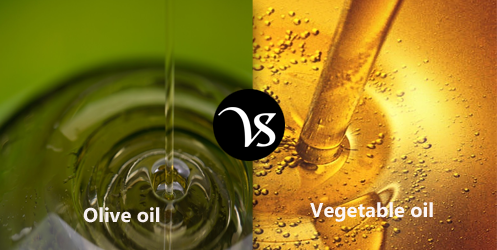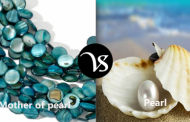 Olive oil:
Olive oil:
The oil which is extracted by the olive fruit and mostly used for cooking, cosmetics, soaps and pharmaceuticals is known as olive oil. It is rich in anti-oxidants and mono-unsaturated fat. It has a distinct flavor. It is beneficial to the heart. It is green in colour. Olive oils have low smoke point. It is used for the salad dressing as well. Olive oils are known to be very good for skin.
Vegetable oil:
The oil which has been extracted from different plants is known to be vegetable oil. Such as: peanut, soy, sunflower, rapeseed, maize, coconut, palm and olive. It is solid at room temperature. It is rich in Omega 6 fatty acid which is important for a healthy lifestyle. It is yellow in colour. Vegetable oils are used to make soaps, candles, perfumes, skin and cosmetic products. It can be edible as well as non-edible.
Differences:
| Basis | Olive oil | Vegetable oil |
|---|---|---|
| Definition (www.oxforddictionaries.com) |
Oil obtained from olives, used in cookery and salad dressings. | Addiction to the consumption of alcoholic drink; alcohol dependency |
| Synonyms | Oil, balm, vinaigrette dressing ingredient | Avocado oil, castor oil, corn oil, drying oil, animal oil |
| Types | The three types of olive oil are:
|
The types of vegetable oil are:
|
| History | Olive oil production has been with humankind since time immemorial, according to evidence that provide the artefacts and archaeological remains of the most ancient civilizations. The olive has been an integral part of life in the eastern Mediterranean from the first stirrings of civilization. There are stone mortars and presses used for olive oil extraction that date back to 5000 BC | Already a few thousand years before Christ did the Chinese make soybean oil, and in the south of Europe they were already using the olive to make their famous olive oil. They understood that by having the sun heat the seeds and plants, oil came to the fore, and could be used for cooking. |
| Word origin | The word olive oil was originated in between 1765-75. | The word vegetable oil was originated in between 1895-1900. |
| Usage | Its uses are:
|
Its uses are:
|
| Properties | The smoke point of olive oil varies from 215° to 242° (extra virgin, having a lower smoke point than the lighter version). | The smoke point of vegetable oils vary and are higher for oils used for frying like canola oil (smoke point 242°), and safflower oil (smoke point 265°). |
| Pronunciation |
|
|
| Fat composition | 14% Saturated Fat and 73% Monounsaturated Fat. | Coconut oil has the highest content of saturated fat (92%). Canola & sunflower oil have the least amount of saturated fats (6% and 9%, respectively), but contain a higher percentage of monosaturated fat (62% and 82% respectively). |
| Rich in | High levels of calcium and iron, vitamins A, C and monounsaturated fatty acids in high levels – natural anti-oxidants | Active fats called Omega-6 polyunsaturated fatty acids |
| Typical Applications |
|
|
| Made of | Olive oil is made of olive fruit. | Vegetable oil is made of different plants such as: peanut, soy, sunflower, rapeseed, maize, coconut, palm and olive |
| Advantages/Benefits | Its benefits are:
|
The benefits of vegetable oil are:
|
| Disadvantages | Its disadvantages are:
|
Its disadvantages are:
|
| Example in Sentence |
|
|





